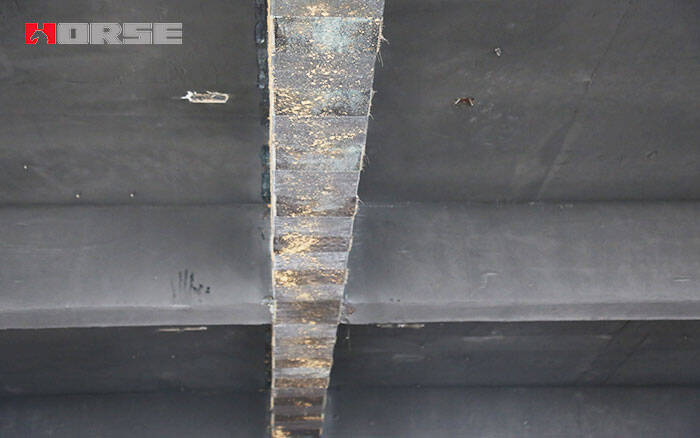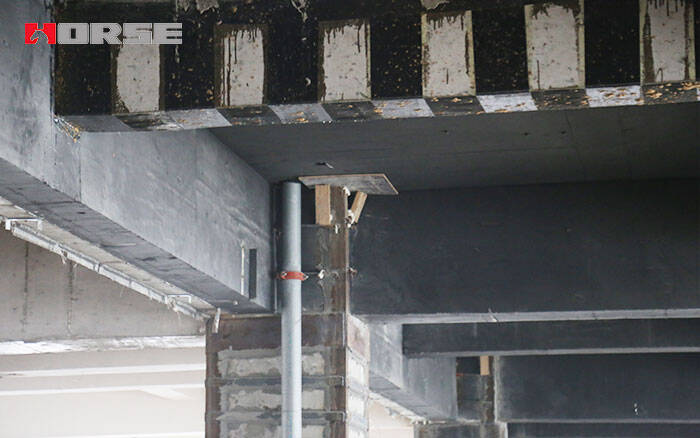Concrete crack repair
Using carbon fiber fabric and epoxy crack injection
In order to ensure the structural safety, through the analysis and comparison of the construction, supervision, design and construction units, the CFRP reinforcement method is finally used to reinforce the frame beam.

Carbon fiber fabric (CFRP) is a new strengthening technology in recent ten years. It has the characteristics of high tensile strength, high modulus of elasticity, light weight, thin thickness, good corrosion resistance and easy to use. Carbon fiber reinforcement technology is the use of resin materials to bond carbon fiber to the surface of structures or components, so that carbon fiber and concrete form a composite whole, through its cooperation with the structure or components, improve the flexural and shear bearing capacity of structural components. So as to achieve the purpose of strengthening and strengthening the structural components and improving the mechanical performance. The reinforcement technology has the characteristics of convenient construction, wide use, no change in the shape and weight of the structure, and has great research and popularization value and market potential.
1 Project overview
During the construction of a dormitory building, a slight through crack was found at the bottom and side of a frame beam with a span of 6 m. The crack width was about 0.2 mm. In order to ensure the structural safety, through the analysis and comparison of the construction, supervision, design and construction units, the CFRP reinforcement method is finally used to reinforce the frame beam.
2 Reinforcement scheme
Before the construction, the material piled on the part of the frame beam is removed to minimize the load acting on the frame beam during the reinforcement construction, then cracks are treated, and finally carbon fiber reinforcement is carried out. Crack treatment: crack width less than 0.2 mm, with epoxy resin surface brush sealing; cracks greater than 0.2 mm with crack injection repair. Carbon fiber reinforcement: Firstly, a wide carbon fiber cloth strip with the same width is pasted on the bottom of the beam, and then a 100 mm wide carbon fiber cloth "U" hoop is pasted with the distance of 200 mm. A 100 mm wide CFRP sheet was pasted on both sides of the beam to reinforce the U-shaped hoop. Finally, a CFRP sheet was pasted on the beam surface with a width of 250+2*100=450mm, as shown in Fig. 1.

3 Epoxy injection for crack repair
In this project, epoxy resin automatic low pressure joint construction technology is adopted to repair and reinforce the micro cracks of the frame beam. The process utilizes the porous principle of concrete and the pressure produced by the shrinkage of elastic rubber film on the rubber injection base to press the epoxy resin with high fluidity into the crack and penetrate into the depth of the crack, so as to recover the concrete.

4 Carbon fiber reinforcement
Construction steps: surface treatment, brushing the primer glue, repairing, leveling, sticking carbon fiber fabric, curing and testing.
4.1 surface treatment
(1) Grinding the bottom and both sides of the whole frame beam with a grinding wheel machine, removing the dirt, floating slurry and loose structure of the concrete surface layer, revealing the compact structure, and smoothing the surface.
(2) grinding the corners of the components into circular arcs with an arc radius of not less than 20mm.
(3) Clean up the dust and sundries on the surface with a blower and wash them with water and alcohol. The next working procedure can be carried out only after the concrete surface is fully dried.
4.2 applying primer
(1) The main agent and curing agent of the underlying resin are weighed accurately according to the prescribed proportion and then put into the special container. The main agent is weighed first, then the curing accelerator is added, stirred evenly, and then the curing agent is added after 1-3 minutes, and stirred evenly with the agitator; the mixing amount should be used up within the service time (about 30-40 minutes).
(2) The bottom resin is evenly coated on the concrete surface with a special roller brush, and the construction of the next process can be carried out only after the resin surface is touched and dried (the resin surface solidifies and hardens).
(3) The underlying resin refers to the contact drying or curing, the surface of the convex part (similar to dew droplet) to use abrasive cloth or grinding machine level.
4.3 patch leveling
(1) Preparing epoxy putty: putty main agent, curing accelerator, curing agent in accordance with the prescribed proportion, accurately weighed into the container, adding sequence with the bottom resin construction requirements, stirred evenly with a mixer; a mixing amount should be used up within the usable time (about 40-50 minutes).
(2) the concave surface of the component is filled with epoxy putty, and the surface is smooth and smooth without any corner. The corner should also be repaired to a smooth circular arc with a radius of not less than 20mm.
(3) the surface of the putty is scratching and scratching, and the sand paper is used for grinding and leveling.
4.4 carbon fiber fabric paste
(1) Carbon fiber cloth should be cut according to the reinforcement design dimension. Carbon fiber cloth should be cut in the same direction as the bonding part. Oblique cutting of carbon fiber cloth should be prohibited and wire drawing should be avoided. The carbon fiber cloth after cutting should be rolled up to prevent wrinkles and bending.
(2) The main agent and curing agent of the impregnated resin are accurately weighed according to the prescribed proportion, and are evenly stirred in a mixer for loading into a container. A harmonic quantity should be used within the available time (about 50~60min).
(3) Re-wipe the concrete surface before pasting carbon fiber. After confirming that there is no dust on the surface, apply epoxy resin evenly to the place to be pasted. When brushing resin, must achieve the "stable, accurate, uniform" requirements, that is: stable, brushing force moderate, as far as possible do not flow not fall off; accurate, accurate in the paste site brushing, brushing and no control line; uniform, uniform thickness within the scope of brushing.
(4) Carbon fiber cloth pasting, the same to "stable, accurate, uniform", to achieve moderate strength, so that the carbon fiber cloth does not wrinkle, not fold, smooth extension. When rolling carbon fiber cloth, it must be rolled many times from one end to the other with a special drum to extrude bubbles. It is not suitable to roll and rub repeatedly in one part. During rolling, the impregnated resin should permeate the carbon fiber cloth sufficiently to achieve saturation. When the carbon fiber sheet needs lapping, the lapping length must be greater than 100 mm, and the resin infiltration quality of the lapping part should be guaranteed.
(5) when sticking on the surface of the carbon fiber fabric, the next layer should be pasted on the surface of the carbon fiber fabric. If more than 40min, should wait for 12h, then brush the binder to paste the next layer.
4.5 Carbon fiber cloth should be maintained after the curing, curing period (especially the initial curing period) should be strictly guaranteed not to be interfered with and collision, the curing period is about 1 week.
4.6 the inspection and acceptance criteria for construction quality are as follows:
(1) compared with the design requirements, the allowable deviation of centerline is less than 10mm.
(2) the amount of carbon fiber paste should be large.
(3) sticking quality: A. when the area of a single empty drum is less than 1000mm2, it is repaired by filling glue; when the area of a single empty drum is more than 1000mm2, it is repaired by cutting; B. the ratio of the sum of the empty drum area to the total sticking area should be less than 5%.
(4) When the bonding quality does not meet the requirements and needs to be cut and repaired, the carbon fiber cloth of the empty drum part should be cut off along the edge of the empty drum, and the same carbon fiber material with each side extending 100 mm to the outer edge should be used to subsidize the original position with the same adhesive.
5 points for attention in construction
(1) Unlike the solidifying agent of impregnated adhesive resin, the solidifying agent of primer and putty should be strictly distinguished from that of impregnated adhesive resin.
(2) If the curing agent contains organic peroxides, iron and copper products should be avoided and containers made of glass, aluminum and stainless steel should be used.
(3) the metering of resin, curing agent and curing accelerator must use a gauge, and the accuracy of the gauge is + 1g. The mixing sequence is: first measure the resin, then add curing accelerator stirring 1-3 minutes, then add curing agent stirring 1-3 minutes. It is forbidden to mix curing agent and curing accelerator simultaneously.
(4) The mixing amount of resin should be used up within the usable time, especially in the construction of impregnating and pasting resin, the mixing amount should be determined after considering the construction time. After mixing the main agent and curing agent, the usable time should be strictly observed, and if the resin coagulates, the use should be stopped immediately. As soon as the setting time of the resin exceeds, it will undergo rapid solidification and can not be used any more. In order to ensure the construction quality, the service time of the resin should be controlled to be about 10 minutes shorter than the setting time.
(5) Carefully check the smoothness of the bonding surface before pasting carbon fibers, otherwise, grinding should be carried out to keep the smoothness of the concrete within 1 mm. Because CFRP can only produce good reinforcement effect if it is in close contact with the reinforced concrete surface, sharp protrusions or corrugated corners on the concrete surface may cause damage to CFRP and reduce its strength.
(6) carbon fiber cloth should be rolled into small rolls after cutting, so as to prevent wrinkles. When storing fiber cloth, avoid direct sunlight and rain, dust and other attacks. Carbon fiber sheets should not be extruded during transportation and storage, so as to avoid damage to the carbon fiber. The cementing material should be stored in a cool and airtight condition.
(7) As carbon fiber is a conductive material, carbon fiber cloth should be far away from electrical equipment and power supply during construction, or take corresponding protective measures;
(8) the preparation of binders should be carried out indoors, and the operating environment and construction site should be well ventilated.
(9) construction workers should wear protective masks and gloves and wear work clothes according to the regulations.
(10) all kinds of cohesive materials should not pollute the source of living water. Waste should not be poured into sewers, and should be treated centrally according to environmental protection requirements.
6 Summary
The damaged frame beam is repaired by carbon fiber reinforcement technology, and the surface is painted and painted according to the normal design requirements. So far, there is no abnormal phenomenon in normal use.
Carbon fiber reinforcement technology has the characteristics of simple operation, quick construction, using only small electric tools in construction, and the construction speed is fast, the construction period is short, does not increase the volume and weight of the structure, does not change the shape of the structure after reinforcement, and does not affect the surface decoration of the structure. Compared with the traditional reinforcement method, it has obvious advantages. With the deepening of scientific research, the accumulation of engineering practical experience and the further exploration and development of new application fields, this technology will be more mature and perfect, and the application of this technology will also show a broader prospect.